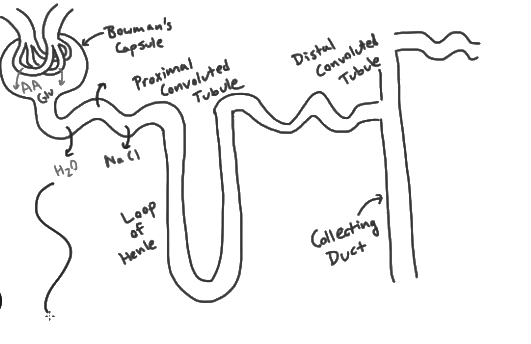MCAT Exam > MCAT Notes > Biology for MCAT > Tubular Reabsorption
Tubular Reabsorption | Biology for MCAT PDF Download
| Table of contents |

|
| Introduction |

|
| How Tubular Reabsorption Works in the Nephrons |

|
| Different Segments of the Nephron and Their Functions |

|
| Implications of Tubular Reabsorption Dysfunction |

|
Introduction
Tubular reabsorption is a vital process that occurs in the nephrons of the kidneys. Its primary function is to return water and solutes from the glomerular filtrate back into the bloodstream, thereby maintaining body fluid balance. This article explores the concept of tubular reabsorption, its mechanisms, and its significance in ensuring the normal functioning of our tissues and organs.
Understanding Tubular Reabsorption
When the blood is filtered through the glomerulus and Bowman's capsule, it forms a substance known as the glomerular filtrate. This filtrate closely resembles blood plasma without the presence of proteins and does not resemble urine at this stage. If this filtrate were to flow directly to the bladder and out of the body, significant volumes of extracellular fluids would be lost daily. However, thanks to the intricate tubular reabsorption mechanisms in the nephrons, essential water and solutes are reabsorbed into the circulatory system, while unwanted substances are secreted into the filtrate. Together, these processes complete the transformation of glomerular filtrate into urine.
How Tubular Reabsorption Works in the Nephrons
The nephrons, which are the functional units of the kidneys, play a crucial role in maintaining body fluid homeostasis. They consist of different segments, each responsible for reabsorbing specific substances. Tubular reabsorption occurs in two steps:
- Step One: Passive and Active Movement: The first step involves the movement of water and dissolved substances from the fluid inside the tubule, through the tubule wall, and into the surrounding space. This movement can occur passively or actively, depending on the substances involved.
- Step Two: Return to the Bloodstream: The second step is the reabsorption of water and substances from the space outside the tubule back into the bloodstream. This can also occur through passive or active transport mechanisms.

Different Segments of the Nephron and Their Functions
The nephrons are comprised of five segments, each performing specific functions in tubular reabsorption:
- Proximal Convoluted Tubule (PCT): The PCT reabsorbs approximately 80% of the glomerular filtrate. Its cuboidal epithelial cells have microvilli on their surface, known as a brush border. This increases the surface area available for reabsorption. The PCT is densely packed with mitochondria, providing the energy required for active transport systems. Sodium, nutrients, and water are reabsorbed in this segment.
- Late Proximal Convoluted Tubule: In the late proximal tubule, chloride ions are reabsorbed, utilizing chloride/formate anion exchangers and passive movement through the tight junctions between epithelial cells.
- Loop of Henle: The loop of Henle is responsible for concentrating or diluting the tubular fluid. Countercurrent multiplication occurs here, aiding in the process. Reabsorption also takes place in the thick ascending limb of the loop of Henle, with sodium and potassium being reabsorbed through specific transporters.
- Distal Tubule and Collecting Duct: In the distal tubule and collecting duct, further reabsorption of sodium occurs, regulated by hormones. Calcium and phosphate reabsorption also take place throughout the nephron, with different segments involved.
Role of Tubular Reabsorption in Maintaining Body Fluid Homeostasis
Tubular reabsorption plays a critical role in maintaining stable extracellular body fluid volumes and the proper levels of essential salts and minerals required for the normal functioning of tissues and organs. Sodium, in particular, is closely regulated as it affects blood volume and pressure. Passive water reabsorption follows the movement of sodium, maintaining extracellular fluid volume and balancing osmotic pressure.
Implications of Tubular Reabsorption Dysfunction
When tubular reabsorption is compromised, various health issues can arise. For instance, the retention of waste products can lead to disturbances in multiple organ systems, affecting cardiovascular, hematological, gastrointestinal, neurological, skeletal, hormonal, respiratory, skin, and reproductive systems. Loss of water and electrolyte homeostasis can result in edema, hypertension, reduced phosphate excretion, loss of bone calcium, and symptoms such as lethargy, nausea, diarrhea, and vomiting.
Understanding Diabetes Insipidus: Diabetes insipidus is a rare disorder characterized by excessive thirst and the production of large amounts of dilute urine. It occurs due to the malfunctioning of antidiuretic hormone (ADH) production, which regulates urine concentration by retaining water in the body. The disorder can be caused by various factors, such as damage to the pituitary gland, defects in the tubules' response to ADH, or hormonal changes during pregnancy.
Conclusion
Tubular reabsorption is a complex process that ensures the return of vital water and solutes from the glomerular filtrate back into the bloodstream. Through various segments of the nephron, different substances are reabsorbed, maintaining body fluid homeostasis. Understanding tubular reabsorption and its role in maintaining fluid balance is crucial for comprehending kidney function and the consequences of its dysfunction.
The document Tubular Reabsorption | Biology for MCAT is a part of the MCAT Course Biology for MCAT.
All you need of MCAT at this link: MCAT
|
233 videos|16 docs|32 tests
|
Related Searches



















